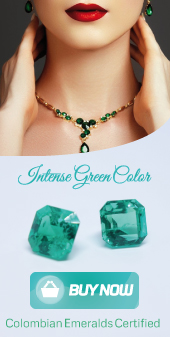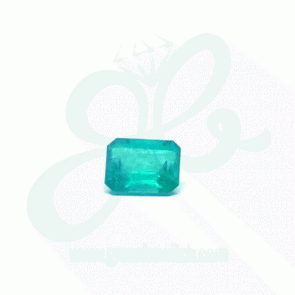COLOMBIAN EMERALDSSMARAGDEالزمرد祖母绿ÉMERAUDESברקתपन्नेSMERALDIエメラルドSMARAGDENSMARAGDERزمردИЗУМРУДЫมรกตZÜMRÜT CERTIFIED
Etymology of the emerald
The origin of the word emerald could come from the Sanskrit of "marakata" or "marakta" which could be interpreted as the greener thing. The root "marak" meant light, brightness. In Persia was denominated with the word "Zabargat" and the Arabs called to him with the name of "Zamarut". If we go back to the word "marakta" we see that its passage to "maragdos" and then to "smaragdos" should not have been so complicated. The phonetic changes occur with the difficulty of some people to pronounce certain sounds as evidenced by the transformation of the Greek "smaragdos" into the classic Latin "smaragdus" and then to "smaraudus".
The word emerald as we know it in Spanish comes from the ancient French "esmeraude" which in turn came from "smaraudus". With the passage of years and trade between peoples the word emerald that in Spanish should have been "esmerode" due to the diphthong "au" becomes "o". Listening to the French the Spaniards heard something similar to "esmeraad" the vowel "u" was not audible to the Spaniards leaving a gap that was filled with the lengthening of the "a". The elongated vowels are not part of the phonetic sounds of Spanish, this space was finally filled with the letter "l" and thus we built the word emerald with which the precious gems are named.
Currently the emerald is designated in several languages as follows:
| German | Smaragd | French | Émeraude | Italian | Smeraldo |
| Arab | زمرد | Welsh | Emrallt | Japanese | エメラルド |
| Bulgarian | изумруд | Greek | σμαράγδι | Malay | zamrud |
| Catalan | maragda | Dutch | smaragd | Norwegian | smaragd |
| Czech | smaragd | Hungarian | smaragd | Romanian | smarald |
| Traditional Chinese | 綠寶石 | English | emerald | Russian | изумруд |
| Danish | smaragd | Irish | iathghlas | Swedish | smaragd |
| Spanish | esmeralda | Portuguese | esmeralda | Turkish | zümrüt |
Emeralds also lived their history in the new world before the discovery of America and so it is important to rescue something from the language culture of the muz which traded and exchanged emeralds for other precious supplies of the time with other peoples of the continent, such as the Incas From Peru and even to Mexico came the emeralds of the Colombian muzos and chibchas. In 1581 Juan Suarez de Cepeda writes a relation of the writing of the Muzos - Colimas where we find interesting words that revolve around the emerald:
- ABIPI: Great I am. Name of a hill where emeralds were found.
- ARE: God, the first creative man.
- AZA: RIO Magdalena.
- NICUA: Salt.
- PAYME: High.
- YOKO: Sit down and rest. Name of a hill where emeralds were found.
- APIPA: brave warrior.
- POPE: father, person of respect.
- TAPAZ: green stone (Emerald)
- TAPACES: Indian muzo-colima (Those of the green stones).
- YVICHICUCO: gigantic mythical snake.
Emerald is a green beryl coloured by trace elements of chromium and vanadium and most are moderately to heavily included with numerous fissures, making them quite brittle. The origin of the name stems from the Latin Esmaraldus, meaning green gem. Throughout early history emeralds were produced in Austria, Pakistan and notably Egypt, where Cleopatra adorned herself with these gems. The ancient Aztecs and Inca civilisations discovered emeralds in modern day Colombia thousands of years ago and these were quickly exploited by the Spanish Conquistadores when they arrived from Europe from the 1490s onwards. A very rare type of Colombian emerald, known as a ‘trapiche,’ exhibits a ‘star’ pattern (and is sometimes referred to as a ‘star’ emerald) comprising a 6 pointed radial pattern, named after the trapiche grinding wheel used to process sugarcane in the region. Colombian emeralds are the most sought after in the world due to their transparency, colour and fire and are most commonly found in the regions of Muzo, Coscuez and Chivor.
The hardness of the emerald gemstones is considered as poor, given that they are highly included gemstones.Colored gemstones like emerald gemstones are classified using four simple parameters: cut, color, crystal and clarity, also known as the four 4Cs.
The cut is defined as the shape of the precious stone, which can be faceted like most cuts, or can be cut cabochon, a rounded cut without hard edges. The most common face cuts are: emerald cut, cushion and oval. Most emeralds have surface breaking cracks, a considerable number of them being cut into cabochon instead of faceted shapes.

The intensity of the green color that the emerald must have to be considered as Colombian emerald of high quality. You must have three simple parameters to qualify Emeralds: Light Green, Medium Green and Dark Green. The color is divided into: hue, saturation and tone; In this way a green emerald green has a primary green color, and a light tone. A dark green emerald is one whose tone is dark and the primary hue is green.
Glass and clarity go hand in hand when classifying Esmeraldas. The Emeralds tend to have cracks. Clarity is classified by the eye unlike diamonds. An emerald-clear gemstone with a dark green color is an extremely valuable gemstone.
Within the emerald trade, the use of cedar oil to enhance the clarity of an emerald stone is an accepted practice, but the use of colored oils is not an accepted practice. The US Federal Trade Commission requires disclosure of any kind of treatment when a treated emerald is sold, and we have taken steps to certify that our certified emeralds sold are 100% natural. Our Colombian emeralds are extracted from the department of Boyacá in the mining areas of Gachala, Coscuez, Chivor, Peñas Blancas and Muzo.
The mining area of Muzo has been highly productive since colonial times. Their Emeralds are widely recognized for their vivid dark green color, although most Muzo emeralds are not as clear, they have a high price on the market. Mule emeralds are renowned for their size. Clarity is a feature that Chivor and Gachala emeralds the dark green emeralds of these areas are considered the highest quality emeralds in the world.
WE HAVE ALL THE EXPERIENCE TO OFFER CERTIFIED EMERALDS OF VERY HIGH QUALITY AND 100% NATURAL AT THE BEST PRICES.
Please indicate the qualities of the emerald of your preference, our priority is the total satisfaction of our customers
WE MARKET EMERALDS CERTIFIED COLOMBIANS BLUISH GREEN 100% NATURALS BRILLIANTS RAREST







